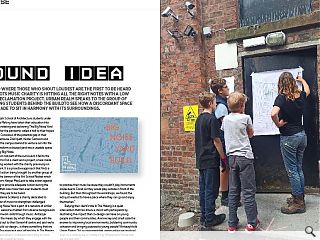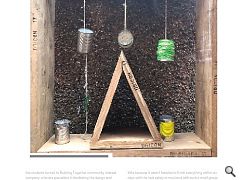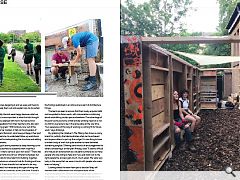Big Noise: Sound Idea
20 Oct 2021
In a world where those who shout loudest are the first to be heard a grassroots music charity is hitting all the right notes with a low key yard reclamation project. Urban Realm speaks to the group of enterprising students behind the build to see how a discordant space has been made to sit in harmony with its surroundings.
A group of Mackintosh School of Architecture students under the banner of In The Making have taken their education into their own hands by initiating and delivering The Big Noise Yard Build in Govanhill after the pandemic called a halt to their hopes of work placement. Conscious of the potential gap in their education Lily Whitehouse, Zoë Hyatt, Kester Samsom and Kasia Antoszyk left the campus behind to venture out into the community and transform a disused yard into a useable space for the music charity Big Noise.
With self-initiation not part of the curriculum it fell to the enterprising quartet to find a client and a project, a task made easier through having worked with the charity previously on university coursework. It is a proactive approach that finds a corollary in the legal action being brought by another group of 35 students under the banner of the Art School Racket which has instructed law firm Harper MacLeod to take action against the school for failing to provide adequate tuition during the pandemic, proving that now more than ever students must make some noise if they are to be heard.
Operated by Sistema Scotland, a charity dedicated to harnessing the power of music to strengthen challenged communities, the Big Noise Yard is part of a network of similar spaces designed to welcome children from diverse backgrounds and teach them teamwork skills through music. Antoszyk explained: “Music is the means by which they engage with the kids and we reached out to their Govanhill centre and said we’re going to do a self-build co-design... is there something that we could do for you?” The approach paid off and the In The Making team soon found themselves in a disused back alley to work their magic and create a useable space.
“Initially it was to be a back alley recording space for kids to practise their music because they couldn’t play instruments inside due to Covid, so they would play outside in front of the building. But then throughout the workshops, we found the kids just wanted to have a place where they can go and enjoy themselves.”
Belying their client’s title In The Making is a quiet intervention that has struck a chord with participants by illustrating the impact that co-design can have on young people and their communities. Are low key and small scale the answer to improving local environments, bolstering community cohesion and bringing purpose to young people? Antoszyk told Urban Realm: “It’s so important that communities get involved, even on a small scale, it’s made a big difference for those kids we worked with.”
Lacking previous experience in undertaking such builds the students turned to Building Together community interest company, who are specialists in facilitating the design and build of community projects, to make sure that the work was done properly and to code. “It was really important for us to use reclaimed materials”, says Antoszyk. “So we used timber from Glasgow Wood Recycling, the parts were not modular but we built them all ourselves. The kids were building it with us. Obviously, under supervision because of all the drilling and hammering.”
Built in just three weeks the programme was as rapid as it was stressful with Antoszy recalling long hours on-site with safety being paramount at all times. “We were with the kids two days a week for three weeks. Outside of those two days, we were there in rotation and we tried to push it forwards a little because it wasn’t feasible to finish everything within six days with the kids safely in mind and with such a small group, so we had to do bits ourselves, but most of it was done with the children.” Complicating matters further was the global pandemic raging around them with the outdoor work providing welcome respite from rolling news coverage of events beyond your control. “We tried to keep as safe as possible. We were outside the whole time, getting tested and you know, making sure we didn’t sneeze at one another,” recalls Antoszyk.
With the sawdust now settled are the team happy with what has been achieved and could the initiative be rolled out elsewhere? “When we started we didn’t necessarily have a fixed vision because it was the kids themsekves who decided what space wthey preferred and what the structure would look like. They were the ones designing it and we were just there to support them and help them out and explain how to do certain things.
“Most importantly the kids were happy because what we think is one thing but more important is what the kids thought and they were all very pleased with how it turned out and then we got some feedback from their teachers who also said it’s used and it’s going great.” With Antoszy now out of the country studying for her masters, it falls on the shoulders of Whitehouse, Hyatt and Samsom, who have just begun their part 2 architecture programme, to undertake follow-up workshops with the client that will include painting the structure and adding more decorative elements.
The decision to go it alone presented a steep learning curve for a team more accustomed to academia than imperfect reality, so what was it like to serve as your own boss? “There was a lot of time management around four different schedules but we were very fortunate to have help from Building Together, they gave us good advice on where to look for funding and how to plan out our work. It was stressful but we learnt a lot very quickly and I think that’s not necessarily the type of thing that we would have learned at university during that time. It wasn’t just the construction knowledge that we acquired, but how to run a project, obtain sponsorship and to collaborate.”
Before picking up tools the team reached out to over a dozen professionals to establish what lay in store for them, with the findings published in an online zine as part of Architecture Fringe. The team are keen to ensure that their newly acquired skills can be applied to future work, with conversations continuing about establishing similar spaces elsewhere. One advantage of the post-covid economy is that remote working means it is not as vital for everyone to be in the same place at the one time. “Our experience of this way of working is a strong fit for future work,” says Antoszyk.
By grabbing the initiative In The Making has shown a canny knack for publicity that demonstrates what can be achieved and inspires others to pick up the cudgel. It is one thing to have a written body of work but quite another to have delivered something tangible. Offering some words of encouragement for others considering a similar path Antoszy said: “It seems difficult and may be an achievement as a student but there are so many people who are willing to help and if you just reach out to the right people the process gets much, much easier. We were very lucky in the sense that we were in touch with people who were keen on helping.”
Looking ahead the team have yet to decide if they will maintain their collaboration but are appreciative of the experience gained at a difficult time, bringing hope to others in the process. In The Making has shown that the best lessons in life are often those taught outside the classroom and learnt from experiences.
|
|





